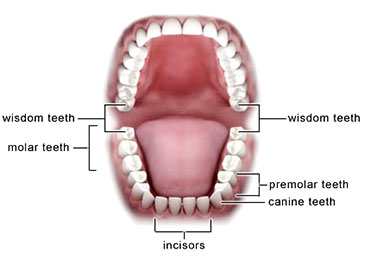MOST PEOPLE’S WISDOM TEETH APPEAR between the ages of 17 to 27 years. They grow in the very back of the lower and upper jaw bones and are the last big molars to develop in the four corners of the mouth. You guessed it… They’re called “wisdom teeth” because people are supposed to be wise by then, right?
Sometimes, wisdom teeth can become a big problem for our patients. When that’s the case, Drs. Bradleywill often suggest that they be removed.
Some wisdom teeth only partially erupt or don’t erupt at all. The term “impacted wisdom tooth” is used to describe this condition which can lead to a host of other problems in your mouth—including gum disease, bone-destroying cysts, crowding or damage to adjacent teeth, and unwanted decay (due to the difficulty in keeping the area clean). For some people, wisdom teeth grow in fine and don’t cause any problems at all.
The illustration below (created by Bupa UK) shows the relationships of all the teeth in your mouth, where your wisdom teeth are located, and how they might look if they grow in without any problems:
 Dr. Boswell and our team have a great deal of experience in extracting wisdom teeth. Whether or not you have obvious problem symptoms, it’s important to evaluate existing or potential problems with your wisdom teeth. Sometimes, removal is the wisest decision for your well-being and oral health.
Dr. Boswell and our team have a great deal of experience in extracting wisdom teeth. Whether or not you have obvious problem symptoms, it’s important to evaluate existing or potential problems with your wisdom teeth. Sometimes, removal is the wisest decision for your well-being and oral health.
Have you had your wisdom teeth removed? Is there an interesting experience you’ve had related to either keeping them or having “let them go”? Share it with us below in the comments section! And if you have questions, let us know.

